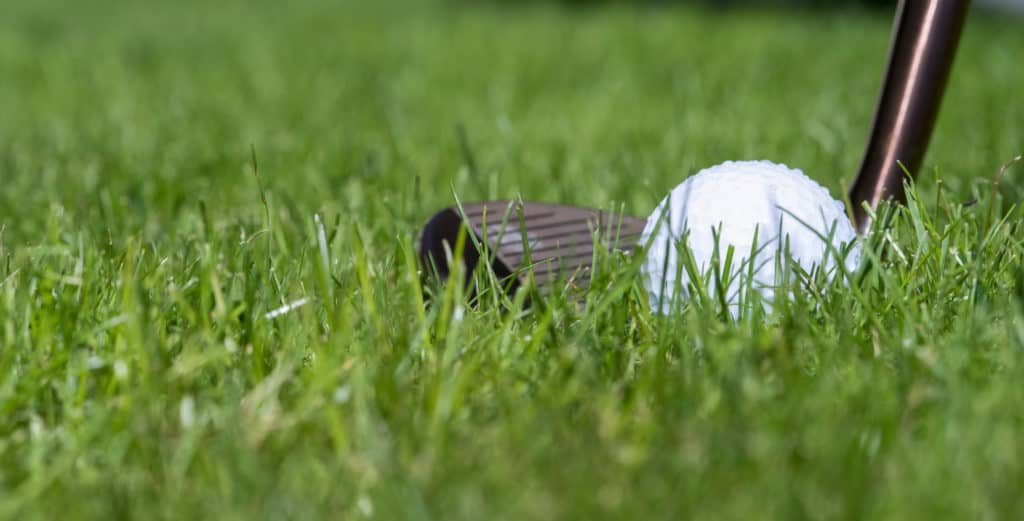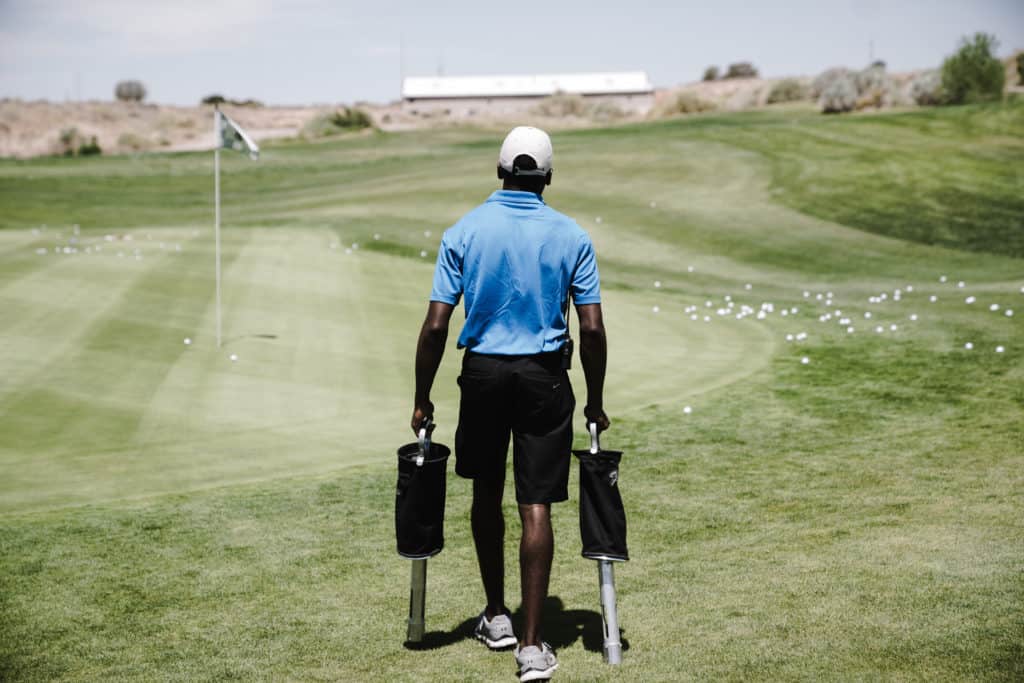Putt whenever you can might be great advice for the majority of golfers! There are two main factors that will impact the decision. The first one the golfer should take into consideration is the skill level of the golfer. The second factor they should consider is the number of variables that might impact the decision.
When many golfers get around the green, they often question whether to hit a putt or to go ahead and hit a chip.
It is a shot that is often debated and most times comes down to the skill level of the golfer and the many variables that a golfer might face when they reach this in between shot.
The ultimate goal anytime you have this shot whether it is from the fringe, fairway or rough is to leave yourself within 3 feet or closer to the hole to have a rather simple tap in putt for your next shot.
Chipping vs Putting: When to hit each shot?
Update: In recent years, I find myself hitting more putts than chips from tight lies. My worse putt is often times better than my best chip. And my worse chip is enough to ruin a great round! The putter is hardly ever a bad option!
Let’s dive into the skill level portion before discussing the variables.

Chipping vs Putting: Skill Level
The more skilled the golfer is, the higher probability that the chip shot would be the better option or at least be considered if the putt would not give the golfer a chance to make the shot. The lower the ability level of the golfer, the more they should highly consider reaching for the putter and settling for a shot that is within 5-10 feet of the hole.
How to practice chipping at home
The most skilled golfer will have plenty of options on the shot from the fringe, fairway or rough. They could go with the lob wedge, sand wedge, pitching wedge or an iron and hit a bump and run. They have the ability to make clean contact and utilize some loft to help the golfer achieve the best result.
With this decision, the golfer brings some other possibility into play such as poor contact or the golf ball interacting with the ground differently than expected.
For a specific cut off, the golfer with a 10 or higher handicap should putt the ball anytime they are within 5 feet of the green 90% of the time. The golfer with a lower handicap, should take every possible shot into consideration and make the best decision based on their current skill level with the “short game”
Even at the professional level there is a range of skill levels with the short game. Some golfers like Phil Mickelson use a 60 degree wedge with just about every chip and pitch shot, while there are golfers that will vary the club.
The most difficult shot for many amateurs is the shot from a very tight lie. There is very little room for error, especially if the golfer is not using the bounce. The tighter the lie, the more likely the golfer should use a putter or even a club like a hybrid. Just make sure you have practices with a hybrid to understand how the ball will react to the clubface.
Classic Quote on Chipping vs Putting
Your worst putt will usually be as good as your best chip.
Arnold Palmer
Chipping vs Putting: Variables to Consider
- Length of shot
- Wet grass
- Slow greens
- Slope of the green
Variables: Length of shot
The shorter the shot, the more likely it is that the golfer should use a putter. It takes a high level of skill to hit this chip shot with a highly lofted club. On the other side is a really long shot. The golfer might be better hitting a chip and run vs hitting the putter. The golfer might possess better touch on a long chip shot vs the long putt that they might not practice often.
A recommendation is to test out really long shot game shots and hit 10 putts and 10 chip shots with your go to club. Measure your proximity to the pin and assess what is the best option for your skill level.
Variables: Wet grass
The wetter the grass, the slower the shot and the more likely the ball will get slowed down significantly the more time the ball spends on the ground. As a result, the wetter the grass, the more likely you will want to hit a chip vs a putt.
This could happen if you play golf in the early morning when there is dew on the course or after a rainstorm where there could even be puddles on the course.
There is nothing worse than hitting what you think is a good point to see water flying off your ball and the ball slowing down significantly.
What degree wedge is best for chipping?
Variables: Slow greens
The slower the greens, the more likely the ball will once again slow down quickly and it brings the chip shot back into consideration. The key here is to test out the greens before playing and have a general idea of what length putt becomes difficult because of the speed of the greens.
The slower green requires a really long and faster putting stroke, which could make contact on the center of the putter face more difficult.
Variables: Slope of the greens
The more slope, especially early on in the shot, the more likely that the chip shot should be considered. For example, if you have a 60 foot shot and there is a lot of slope in the first 20 feet that a putted shot would have to contend with, you might want to consider a chip shot that eliminates the first 20 feet and flies in the air past that zone.
This keeps the shot more simple as you have less slope to contend with. A 60 foot putt is difficult to judge, but a 60 foot putt with significant slope is that much harder to contend with because it is a shot we don’t often face.

Chipping vs Putting: Other Considerations
Greenside Bunkers
Some golfers might decide to even putt out of a bunker if you are close enough to the green and the bunker has a flat front. You will want to consider the firmness of the sand. The more firm the sand, the better the ball will roll through the sand and onto the green.
Hybrid
If your ball is only 1-2 feet into the rough and within 10-20 feet of the hole, a little bump and run with the hybrid can be a great option. You could use your putter grip and make a putting-like motion, but the ball will fly in the air for 1-4 feet to get past the rough or other grass conditions that you might want to avoid.
Some golfers struggle with the chipping yips the shorter the chip shot is.
Chipping vs Putting: Asses your game
Our recommendation above based on the handicap level of your game is only a general recommendation. There are 15 handicap level golfers who have impressive short games and golfers with a 5 handicap that really struggle around the green.
The weaker you are with your short game, the more likely you should consider a putter. The best way to assess your game is to complete the following challenge:
- Hit 10 shots from the rough with a putter and a wedge – Which one has more shots within 3 feet of the hole?
- Hit 10 shots from a tight lie with a putter and wedge – Which one has more shots within 3 feet of the hole?
- HIt 10 shots from the fringe/fairway with a putter and wedge from 5 feet – Which one has more shots within 3 feet of the hole?
- HIt 10 shots from the fringe/fairway with a putter and wedge from 10 feet – Which one has more shots within 3 feet of the hole?
What golf putter should I buy?

Chipping vs Putting: Similarities
The chipping and putting stroke can have many similarities. The golfer who is struggling with chipping might want to think of the chip shot as an extended putt, just with a wedge in their hands. Keeping this simple back and forth motion can help the golfer build some consistency in their contact and distance control while chipping. Too many golfers whether slow down or speed up when chipping, resulting in poor contact and a lack of distance control.
My Secret To Golf Improvement
Let’s face it, in order to get really good at golf, we must practice frequently. About three years ago, I made the leap and invested in a golf simulator build for my garage. I went with a SkyTrak Launch Monitor and the TGC software and can now play over 100,000 courses including Augusta, Pebble Beach, Bethpage Black, Whistling Straits. St. Andrews and many other of the top 100 courses in the world.
This golf simulator setup, which is more affordable that you might imagine, has been a game changer. I can now play golf everyday of the year regardless of rain, snow, cold weather or time of day. I can practice or play rounds of golf. I can stand in the 11th fairway at Augusta and with the auto-rewind feature I am able to practice my approach shots from various differences.
It is worth checking out through Rain or Shine Golf as they offer some incredible packages along with financing offers that are difficult to beat.
Some direct links to Rain or Shine Golf for pricing and financing:
Take Action – What You Can Do Today to Get Better
What does this mean for you? I believe in the following recipe to get better:
1 – Improve your motion in the golf swing by identifying a golf instructor. Here are some options:
Here is a list of golf instructors that we have reviewed:
2 – Train to swing faster and improve your swing speed. Here are some options:
Looking to gain more Speed and Distance in your swing. Two Options:
3 – Understand course strategy and work to break through your next barrier. Here is a series on breaking through:
We have provided guides on how to break 100, 90, 80 and 70. Check out more below, if interested.
4 – Practice Frequently
Did you know that I build a golf simulator in my garage and have played over 500 rounds of golf on my SkyTrak system? It has been a game changer and one worth checking out. Here are some of my other posts on golf simulators frequently asked questions:
- Is a Golf Simulator Worth It?
- How to Build a Golf Simulator?
- What is the Best Golf Simulator?
- Golf Simulator Accessories?
- How to Build a Golf Simulator for under $7000
- Top 11 Reasons to Buy a SkyTrak
- How to Build a Golf Simulator for Under $1000
- Why Build A Golf Simulator?
- What Space is Needed?
- Can A Golf Simulator Improve My Game?
- How Much Does A Golf Simulator Cost?
- Don’t Forget to Check out our 15 best golf swings of all time.
